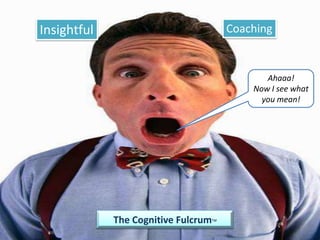Creative Coaching
- 1. InsightfulCoachingAhaaa!Now I see what you mean!The Cognitive FulcrumTM
- 2. Proposition: Coaching is a creative act which seeks to facilitate a creative insight on the part of the coacheeTRY Experiencing Insight……..what do you see on the next slide
- 4. If you just saw random dots in the last slide, go back and look again… Try thinking dog…….
- 6. Effective Coaching The person being coached “joins the dots” and has an “Ahaa” moment of insight
- 7. They suddenly see their behaviour or thoughts from a new perspective
- 8. The insight is like a Cognitive FulcrumTM which reorients their perspective and enables a way forward
- 9. The best coaches facilitate such insight
- 10. As coaches, how can we best facilitate the insight?Coaching is a creative act
- 11. Early Experiment – Insight Psychologist called Kohler*
- 12. Chimpanzees left in cage with food just out of reach
- 13. A number of sticks were left within reach
- 14. After lots of failed attempts to reach the food:
- 15. They suddenly stop
- 16. Appear to be thinking hard
- 17. They look at the sticks
- 18. They use the sticks to reach and obtain the food.Interestingly, they tended not to display such “insightful thinking” if they were too hungry – the level of “arousal” INHIBITED THE INSIGHT. * Kohler, Wolfgang (1925). The Mentality of Apes. Norwood, NJ: Ablex
- 19. And it’s not just Chimps….Albert Einstein finally hit on the core idea underlying his famous theory of relativity one night after months of intense mathematical exercises. He had given himself a break from the work and let his imagination wander about the concepts of space and time. Various images that came to mind prompted him to try a thought experiment: If two bolts of lightning struck the front and back of a moving train at the same time, would an observer standing beside the track and an observer standing on the moving train see the strikes as simultaneous?* ...Guenther Knoblich and Michael Oellinger November/December 2006 issue of Scientific American Mind.
- 20. Coaches often use a framework based on Johari’s Window to describe how individuals have “blind spots,” public and private “facades,” and aspects of their potential.This Framework can be useful in exploring the role of insight in coaching
- 21. The Johari windowKnown bySelfUnknown bySelf13Known byothersUnknownBy others42Based on: Luft, J.; Ingham, H. (1955). "The Johari window, a graphic model of interpersonal awareness". Proceedings of the western training laboratory in group development (Los Angeles: UCLA)
- 22. Known bySelfUnknown bySelf13Known byothersFeedback/360& Coaching insightsIncrease by self-disclosure, encouraged by CoachingExploration/ InsightUnknownBy othersExploration/Insight42Based on: Luft, J.; Ingham, H. (1955). "The Johari window, a graphic model of interpersonal awareness". Proceedings of the western training laboratory in group development (Los Angeles: UCLA)
- 23. GROWmodel of CoachingGoalRe-interpretRealityWill to ActionOpen Options
- 24. Reality Tell me what is happening just now
- 25. What are the impacts/ consequnces
- 26. How does it make you/others feel
- 27. Tell me more / how / who / what / when
- 28. Can you give me an example/ more examples Re-interpretRealityAsking open questions to get the person thinking more broadly about the issueDo not offer any judgements or solutions - keep away from solutionsYou may find that you need to go back and review the goalThe more depth in this stage, then the more effective the coachingGoalRe-interpretReality
- 29. GoalRealityOption 1Option 2Option 3Option 4Option nOptionsWillThe more the coachee explores their Reality, the more likely they are to “join the dots” and have an insight.The level of insight will determine the number/ power of the Options
- 30. The Cognitive FulcrumTMCoaching is a Creative ActLooking too directly at the problem makes us think Convergently, focussing in on our narrow viewThis precludes/interferes with the need to think Divergently/laterally which is necessary if we are to raise awareness and develop alternative optionsMetaphors, analogies, narrative, meditation, mindfulness and other coaching devices all provide a prism through which we can see our issues (obliquely) from a different perspective. It is proposed that such coaching devices act like a prism, facilitating divergent AND convergent thinking. The prism mechanism enables switching fast between both Divergent and Convergent thinking modes Initially, we think divergently and expand our awareness of the issue. Then, at a certain point, the switch flips through the cognitive fulcrum, and we begin to think Convergently, and the relevance of the new information and its application to the real problem becomes apparent. At that point we converge on the real issue, before diverging again as the richness of the prism opens up additional lines of enquiry.
- 31. THE COGNITIVE FULCRUMTMGROW COACHING MODELCREATIVE THINKING MODEL*Preparationpreparatory work on a problem that focuses the individual's mind on the problem and explores the problem's dimensionsGOALThe Cognitive FulcrumIncubationREALITYwhere the problem is internalized into the unconscious mind and nothing appears externally to be happeningNarrativeReframingMetaphorMeditationSilence IntimationConvergentDivergentSwitchingThe person gets a "feeling" that a solution is on its wayOPTIONS Insight Option 1Option 2Option 3Option nwhere the creative idea bursts forth from its preconscious processing into conscious awareness  VerificationWILL to ACTwhere the idea is consciously verified, elaborated, and then applied* Graham Wallas Art of Thought 1926
- 32. So, what can the coach do, to encourageand facilitate an insight? Create a relaxed rapport
- 33. Open questions & active listening
- 34. Give them time and space
- 35. Use imagery, analogies,metaphor, narrative
- 37. Projective fantasy
- 38. Help “convergers” diverge
- 39. Help “divergers” converge
- 40. Above all…Silence is Golden – very often when the person being coached is silent they are doing their most useful work – insights are often preceded by silence

















